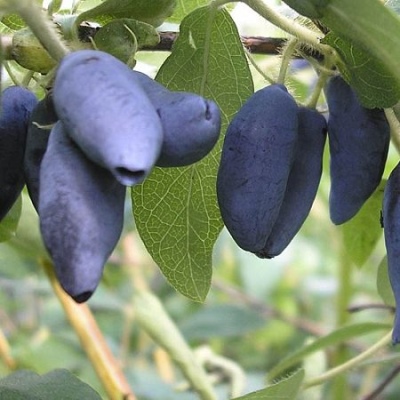
- Authors: South Ural Research Institute of Horticulture and Potato Growing
- Growth type: vigorous
- Bush height, m: up to 2
- Escapes: strong, firm, well leafy
- Leaves: of various sizes and shapes - from oval to linear-oblong
- Flowers: bisexual, small, yellow, collected in small inflorescences
- Fruit size: large
- Fruit weight, g: up to 2
- Fruit shape: pitcher-shaped
- Crumbling: do not crumble for a long time
The Strawberry variety is a variety bred in Altai. Differs in frost resistance and unpretentiousness. Dessert fruits with a characteristic strawberry aroma: they are frozen, dried, compotes, preserves, and jams are prepared. Honeysuckle of this variety is used as a fruit shrub and for gardening in the form of a hedge.
Breeding history
The variety was obtained on the basis of the South Ural Research Institute of Fruit and Vegetable and Potato Growing.
Description of the variety
The bush is vigorous, up to 2 m high, the branches are strong, strongly leafy. Honeysuckle tends to flake off the bark after 4 years of age. The oval or oblong leaf can be of different sizes, bright or dark green. The flowers are small, yellow, bell-shaped, collected in inflorescences. Blooms in May-June, flowers can withstand frosts down to -10 degrees. Propagated by cuttings, dividing the bush or layering.
Fruit characteristics
The berries are large, weigh up to 2 g, have the appearance of a small jug, blue-violet in color, the skin is thin, the flesh is tender. The fruits almost do not tolerate transportation, they are stored in the refrigerator for 4-5 days.
Taste qualities
The taste is sweet and delicate, slightly sour, with a strawberry flavor and aroma. The product contains: amino acids, sucrose, fructose, vitamins C, A, B, calcium, phosphorus, copper, potassium, iodine, magnesium.
Ripening and fruiting
The plant begins to bear fruit in the second year after planting, then annually. It is considered an early variety in terms of ripening, the fruits ripen in the second half of June not at the same time, are not prone to shedding. The berries on the branches remain juicy and fresh for a long time, they can be removed manually or mechanically.
Yield
An average of 4 kg is removed from one plant.

Growing regions
The variety can be grown throughout Russia.
Self-fertility and the need for pollinators
A self-infertile variety, at least 3 varieties are planted nearby to obtain a harvest: Bazhovskaya, Sineglazka, Success, Delight.
Growing and care
Young bushes are planted on the site at the end of September, in colder regions a week or two earlier. When planting in clay soils, sand must be added, and chalk or lime in acidic peat soils. After planting, the seedlings are watered 1-2 times a week. The shrub develops slowly for the first 3 years. The plant can be fed at the end of April and at the beginning of June with a mullein solution - 1 liter per 1 bucket of water or bird droppings - 1 liter per 20 liters of water.
Adult honeysuckle watering requires regular but moderate watering. She does not tolerate stagnant moisture at the roots. Requires weekly watering in May and early June, especially on sandy soil. Watering is stopped 10 days before harvesting. After irrigation, the soil is loosened and mulched with humus or peat. In dry hot weather, the crown must be sprinkled for 6-7 minutes: early in the morning and late in the evening, so that the foliage does not burn out in the sun.
In the fall, it is necessary to carry out sanitary pruning: dry and broken branches are removed. At the 6th year, they begin to do anti-aging pruning - they remove the oldest shoots on which berries do not form.Even after strong pruning, 10-15 skeletal branches are left on the bush. They are not cut off near the very surface of the soil; a gap of 40 cm is left to the cut point.
After harvesting in the summer, fertilize with nitrofoskoy - 1.5 tbsp. l. for 1 bucket of water or manure, diluted in proportions of 1: 4. Every autumn, make phosphorus and potassium dressings: superphosphate - 30 g per 1 sq. m and potassium salt - 20 g. In the spring, after the snow melts, they are fed with urea - 30 g per 1 sq. m. m.


Disease and pest resistance
Honeysuckle has an average immunity to fungal diseases, it can be affected by powdery mildew. Treatment with colloidal sulfur, Bordeaux liquid, means "Skor", "Vector" helps from it. Copper sulfate and Fundazol work well against ramulariasis, cercospora. Strawberry is resistant to the attack of insects, but it can be affected by honeysuckle aphids, leaf beetle caterpillars, false scutes, honeysuckle mites, the drugs "Confidor", "Rogor" effectively work from them.

Winter hardiness and the need for shelter
Winter-hardy look, withstands temperatures up to -35 degrees. To protect it from snow, the bush is tied with twine so that the branches do not break.
Location and soil requirements
The culture prefers moisture-absorbing loamy and sandy loamy substrates, loose, water- and air-permeable, slightly acidic, but neutral are better suited. Can grow in shallow lowlands, but with pre-equipped drainage. Groundwater should be no closer than 1 m from the surface of the earth. The plant prefers bright places, but can grow in partial shade, tolerating the polluted air of city streets. The site must be well protected from the wind. Direct sunlight throughout the day can damage the leaves.

Review overview
The variety has earned praise from gardeners for its pleasant taste and ease of collection. They note that the bushes are unpretentious to care for and very strong, and they also close one side of the site instead of a fence. Children really like the taste of berries.































































